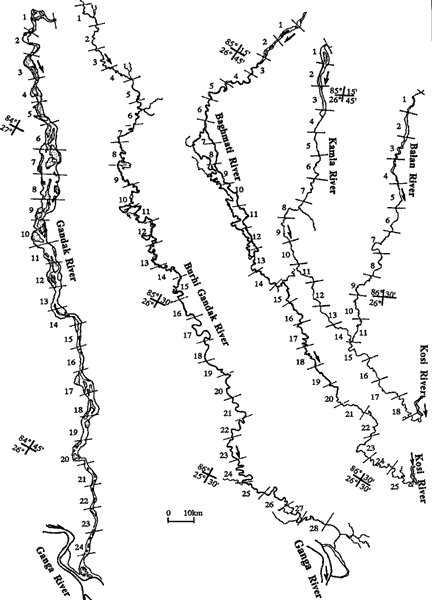|
In general, channel morphology is studied in planform, cross-sectional view
and through the longitudinal profile. The classical descriptions of channel
planform by Wolman and Leopold (1957) include braided, meandering and
straight. A braided pattern is developed after deposition of an initial
central bar. Gradual growth of the central bar deflects the main current
against the channel banks causing them to erode (Schumm and Khan, 1972). A
braided pattern once established may be maintained with only slow
modifications. Meandering rivers develop sinuous channels and are essentially
single-channel systems with no central bar.
The amounts of braiding and meandering displayed by the rivers vary greatly
from river to river and along the course of particular rivers. A braided
stream can change into a meandering one in a relatively short reach, while
individual channels of a braided stream may meander. However, straight
channels are not common in nature. Reaches which are straight for distances
exceeding ten times the channel width are rare (Schumm, 1972).
We follow the modified scheme of Friend and Sinha (1993) to describe the
plan form of the channels. The sinuosity and Braid-channel ratio are defined
as follows:
Sinuosity P = Lcmax/LR
Braid-channel ratio, B = Lctot/ LR
where Lcmax is the mid-channel length for the same reach, Lctot is the sum of
the mid-channel lengths of all the segments of primary channels in a reach,
and LR is the overall length of the channel reach (for single channel system)
or the mid-channel length of the widest channel through the reach
(multi-channel system).
This modification allows measurements readily from topographical maps, aerial
photographs and satellite images and also has the advantage that the channel
length is unlikely to change in a major way with changes of river water level.
This modification is also useful when the rivers show transition between
single-channel and braided morphologies. The new definition of sinuosity can
be employed to every river no matter it has single or multiple channel or
both. In case of multiple channels, mid-channel length of the widest channel
in each reach of channel belt is taken into account.
The specification of primary channels recognizes that some braiding patterns
display a scaling hierarchy of channel sizes (Rust, 1978) and that only the
major ones should be used for this measurement. The widest channel in a reach
should be taken as the major channel. In essence, the braid-channel ratio of
Friend & Sinha (1993) measures the tendency of a channel belt to develop
multiple channels in any reach. If a reach has only a single channel, with no
braids, B will have a value of unity and will thus compare with the
measurement of sinuosity (P), which will have a minimum value of unity.
The rivers
draining the interfan area have variable plan form geometry. In comparison
to the fan rivers such as Gandak which are multi-channel systems throughout,
the foothills-fed Baghmati has multiple channels in its upper reaches
and then becomes single-channel system with variable sinuosity. This
restricted zone of upstream braiding seems typical of these foothills-fed
rivers and probably reflects the heavy monsoonal rains of the foothill zone
and the ready availability of sand-grade sediment from the foothills. In
downstream reaches, the Baghmati is clearly anastomosing, with a
well-developed southwestern anabranch. Sinuosity tends to be relatively high
in the lowest reaches, just before the confluence with the Kosi.
The plains-fed Burhi Gandak River has highly variable sinuosity,
ranging from 1.37 till 3.38. The sinuosity appear to be highest in
mid-stream reaches (8 to 15), where the river traverses a belt containing a
spectacular array of very highly sinuous paleochannels. It seems likely that
the high sinuosity values in these reaches of the Burhi Gandak are due to
the partial occupation of the sinuous paleochannels, and to the influence of
the variable substrate they have left.
The mixed-fed Kamla-Balan River has multiple channels in the upper
parts and in lower parts, the rivers are single channel, with high average
sinuosity, though the values of sinuosity vary greatly from reach to reach.
The two systems join each other at more than one point, and there is
historical evidence that the location and pattern of the confluences has
changed considerably.
|
 |
Variation of Sinuosity and Braid-channel Ratio
Too see the Variation of Sinuosity and Braid-channel Ratio
click on a
chosen river in the map.
To see the whole table in one view
click here
Measurement of the rivers of North Bihar plains has been done at a
regular interval of 10 km using 1:63360 scale topographic maps, dating
between 1905 and 1947
A generalized diagram of the variation of range of sinuosity (P) and
braid-channel ratio (B) expected in natural rivers.

|
The most commonly used index of channel shape is width (w) to depth (d) ratio
even though it is not always the most appropriate. This index gives the gross
dimensions of the channel but do not uniquely define cross-sectional shape.
Idealized cross-sections of the channels, based on the hydrological data for the
interfan rivers are shown. The interfan rivers have low width-depth ratio and
low bankfull discharge compared to the fan rivers, which are characterized by
high width-depth ratio and very high bankfull discharge.
|